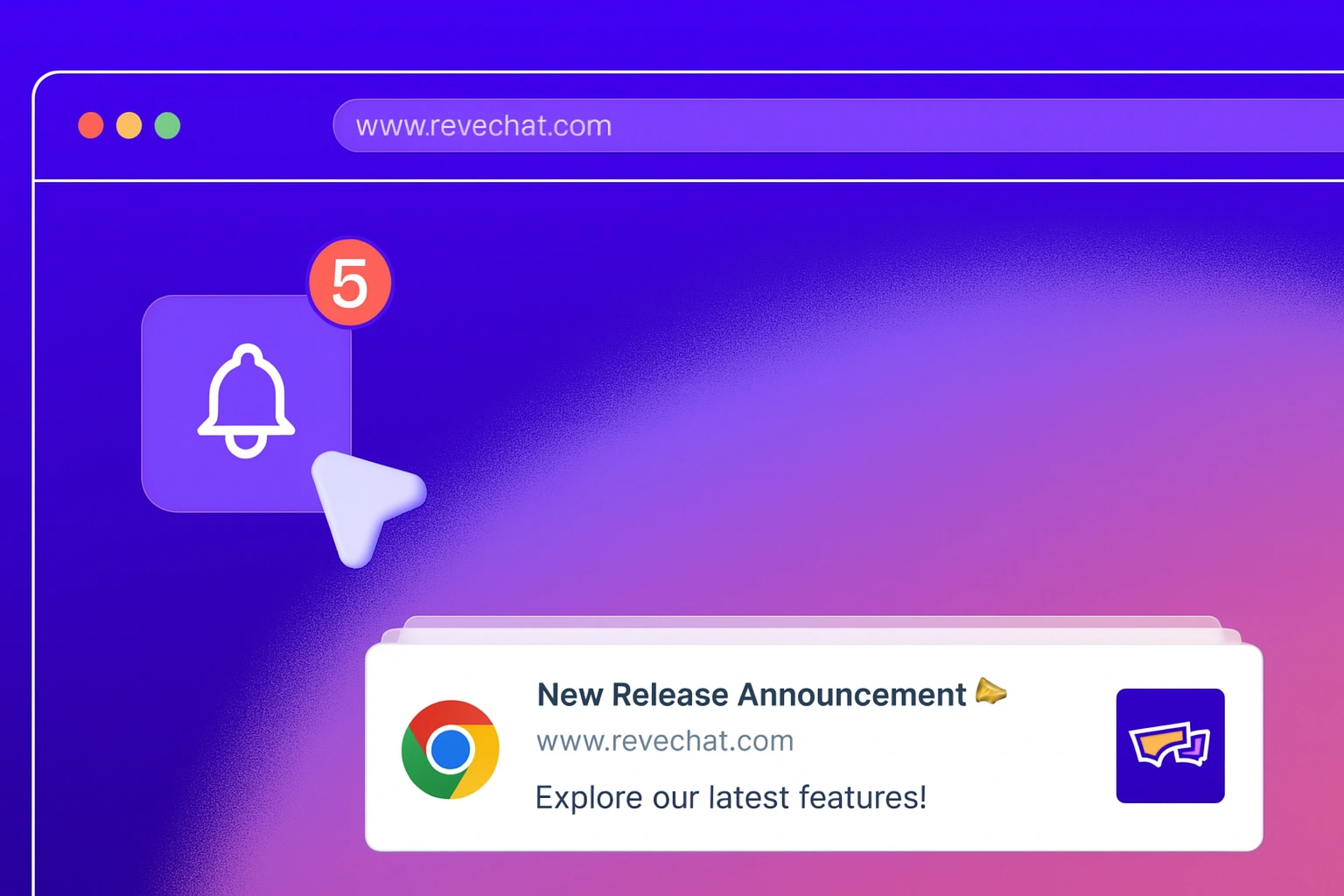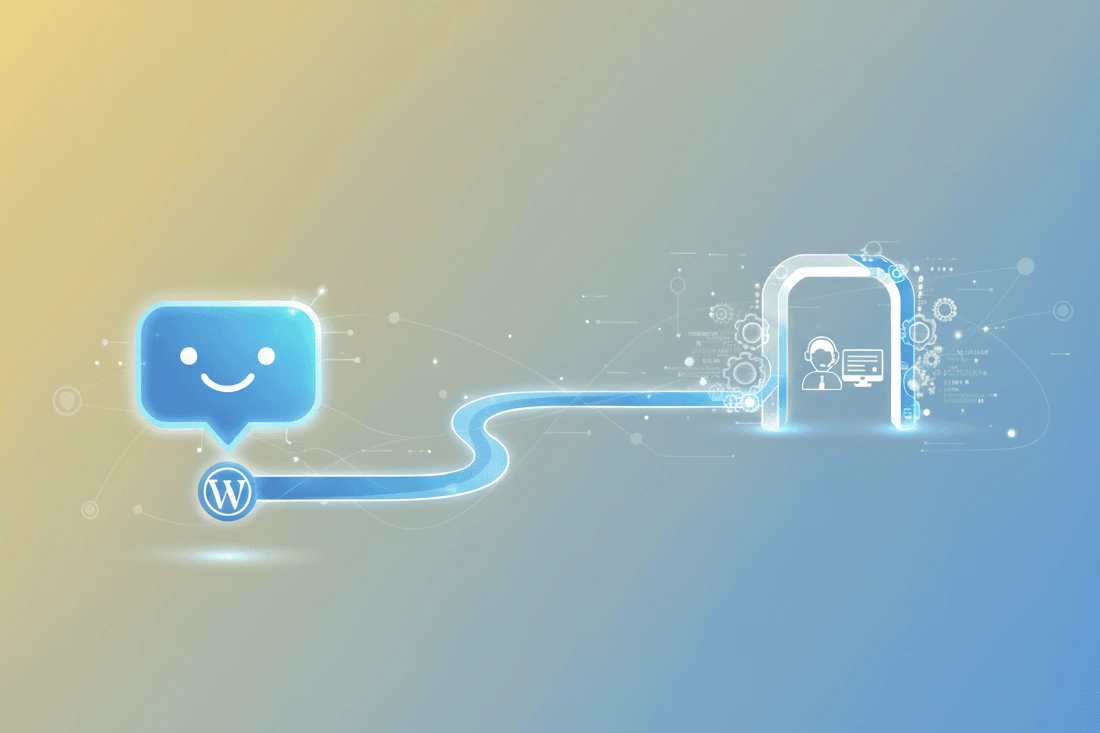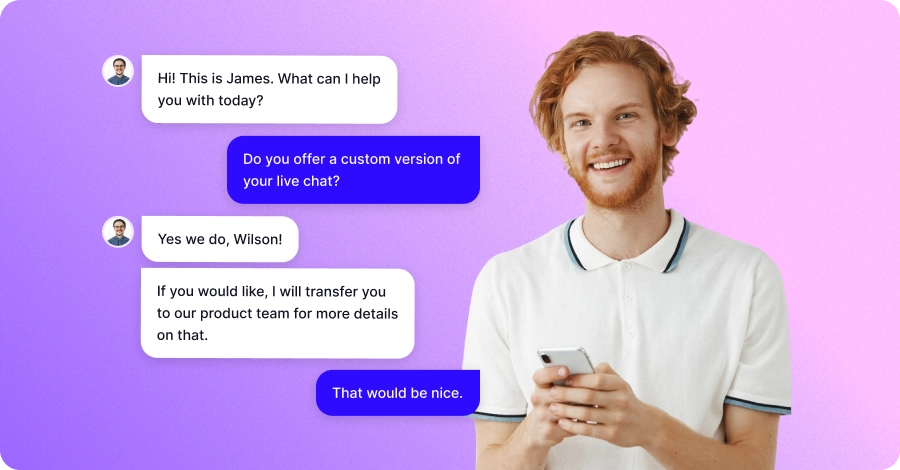How to Handle Difficult Customers: 12 Tips & Examples
- January 19, 2025
- 19 mins read
- Listen

You’re at your desk, juggling multiple tasks when a customer walks in—or calls—with a tone that makes it clear they’re not happy.
Their words are sharp, and they’re upset about an issue that wasn’t even your fault. You can feel their frustration spilling over, but you also know it’s your job to diffuse the situation and find a solution.
Sounds familiar?
Whether it’s the customer who demands instant solutions, one who refuses to listen, or someone simply having a rough day, dealing with difficult customers can be a real challenge.
But how you handle these situations can make or break the customer’s trust in your brand.
Studies reveal that 78% of customers will stop doing business with a company after just one poor experience, and 67% blame bad customer service for their dissatisfaction.
In this blog, we’ll share actionable tips and real-life examples to help you deal with difficult customers with professionalism and confidence.
Types of Difficult Customers
Every business or customer service representative encounters challenging customers. Understanding the types of difficult customers you’re dealing with is the first step to managing these situations effectively. Let’s explore the common types and how you can handle them
The Impatient Customers
You’ve probably met them, the ones who seem like they’re in a constant rush. They hate waiting, and even a few extra seconds can feel like an eternity to them.
What they really want is immediate attention. They’re not trying to make your life harder. They just need to know someone is on it, solving their problem as quickly as possible.
How to Handle Impatient Customers:
- Acknowledge their urgency and reassure them that their issue is your priority.
- Provide a clear timeline for the resolution and keep them updated.
- Use calming and confident language to manage their expectations.
Learn more: How to Deal with Rude Customers: Strategies & Tips
The Know-it-all Customers
These customers come in with all the answers, or at least they think they do. It can be tempting to get defensive, but what they’re really looking for is validation.
They want to feel like their knowledge is respected, even if they’re a little off track. If you can show them that you’re listening and gently guide them to the right solution, you’ll earn their trust.
How to Handle Know-it-all Customers:
- Respect their opinions and acknowledge their knowledge.
- Gently guide the conversation by framing your suggestions as enhancements or validations of their ideas.
- Back your advice with facts or data to build credibility.
The Demanding Customers
These customers are the ones who push for more, no matter how much you’re already giving. They can seem impossible to please, but here’s their secret: they just want to feel important.
They want to know their issue matters to you. A little extra effort in showing them that they’re a priority can go a long way.
How to Handle Demanding Customers:
- Stay professional and calmly set clear boundaries.
- Emphasize what you can do for them, rather than focusing on limitations.
- Document agreements or promises to avoid misunderstandings later.
The Angry Customers
Angry customers are the most emotionally charged of all. Their frustration is often rooted in disappointment, whether it’s due to a product failure, service lapse, or unmet promises.
They seek empathy, acknowledgment, and a genuine effort to resolve their issues. Beyond the resolution, they want to feel that their grievances are being taken seriously and that their negative experience will not be repeated.
How to Handle Angry Customers:
- Stay calm and avoid responding emotionally.
- Listen actively, allowing them to express their concerns fully.
- Apologize sincerely, empathize with their situation, and work towards a solution.
Learn more: How to Handle Angry Customers: 17 Tips & Examples
The Complaining Customers
Some customers always complain, seem to notice every little flaw, and aren’t shy about pointing it out. They often come to your support team and provide customer complaints, give you feedback and sometimes leave negative reviews.
How to Handle Complaining Customers:
- Address their complaints directly and take responsibility where appropriate.
- Offer a solution or alternative to rectify the issue.
- Follow up after resolving the problem to ensure satisfaction.
Learn more: How to Handle Customer Complaints
The Hard-to-Satisfy Customers
Some customers are just hard to satisfy, no matter what you do. You’ve been there, right? They’ll always find something to nitpick, but at the end of the day, they’re perfectionists.
They want consistency and effort. Even if you can’t meet their every demand, they’ll appreciate your genuine attempts to try.
How to Handle Hard-to-satisfy Customers:
- Clearly define what you can deliver and communicate it upfront.
- Focus on providing the best possible service while staying firm on what’s feasible.
- Seek feedback to understand their expectations better and adjust accordingly.
The Indecisive Customers
The indecisive customers are the ones who can’t seem to make a decision no matter how much you guide them. It’s not that they’re trying to waste your time.
They’re just nervous about making the wrong choice. They need patience and clear, simple options to help them feel confident about their decision.
How to Handle Indecisive Customers:
- Ask open-ended questions to understand their needs and preferences.
- Provide limited options to simplify their decision-making process.
- Be patient and guide them with clear recommendations.
12 Ways for Dealing with Difficult Customers
- Always Try to Stay Calm to Control the Situation
- Listen Carefully And Give The Customers Space To Express Themselves.
- Show Genuine Empathy And Build A Connection To Ease Tension.
- Use Positive Language To Turn The Conversation Around.
- Ask Thoughtful Questions To Uncover The Root Of The Problem.
- Present Clear And Actionable Solutions To Resolve Their Issue.
- Suggest Alternatives When The Ideal Solution Isn’t Possible.
- Set Realistic Expectations And Avoid Over-Promising.
- Collaborate With Your Team When You Need Extra Support.
- Thank The Customer For Leaving A Positive Final Impression.
- Follow Up To Reinforce Trust And Ensure Satisfaction.
- Identify Ways To Prevent Similar Issues In The Future.
Having a clear strategy can make all the difference when dealing with difficult customers. Here are 12 actionable ways to help you navigate challenging interactions while maintaining professionalism and leaving a positive impression.
1. Always Try to Stay Calm to Control the Situation
When faced with a difficult customer, your ability to remain calm is invaluable. Staying composed helps you think clearly and sets a positive tone for the interaction.
Customers often mirror the demeanor of the person they’re speaking with; by maintaining your cool, you encourage them to do the same.
Frontiers research indicates that employees who effectively manage their emotions are better equipped to handle customer interactions without escalating conflicts.
Practical Steps:
Take Deep Breaths: Before responding, take a moment to breathe deeply. This simple act can help reduce stress and center your thoughts.
Pause When Needed: It’s okay to take a brief pause to collect your thoughts before replying. This ensures your response is measured and appropriate.
Maintain a Steady Tone: Speak in a calm, even tone. Avoid raising your voice, even if the customer becomes agitated. Your steady demeanor can help de-escalate the situation.
2. Listen Carefully & Give The Customers Space to Express Themselves
When customers are upset, one of the best things you can do is give them space to express their frustrations. Most of the time, they don’t just want a solution, they want someone to listen and validate their feelings.
By letting them vent, you show them respect, build trust, and open the door to a more constructive conversation. 68% of customers leave a company because they feel the business is indifferent to their complaints. Listening actively can prevent this and help you retain their trust and loyalty.
Practical Steps:
Stay Quiet & Listen: Avoid interrupting or jumping to conclusions. Allow the customer to explain their concerns fully.
Acknowledge Their Feelings: A simple acknowledgment like, “I understand how frustrating this must be for you,” can work wonders in diffusing tension.
Use Non-Verbal Cues: Nod occasionally, maintain eye contact (if in person or video chat), and respond with neutral phrases like “I see” or “I understand” to show you’re engaged.
3. Show Genuine Empathy & Build a Connection to Ease Tension
Dealing with difficult customers starts with empathy, the ability to put yourself in their shoes and truly understand their frustrations. Often, customers are not just looking for a fix; they want someone to acknowledge their feelings and show they care.
A Salesforce article reveals that 72% of customers expect empathy from service agents, but only 38% feel they actually receive it. This gap represents a powerful opportunity to connect with your customers on a human level.
Practical Steps:
Use Empathetic Phrases: Incorporate phrases like, “I’d feel the same way in your position,” or “I completely understand why this would be upsetting.” Empathy statements make the customer feel heard and understood.
Mirror Their Concerns: Rephrase their issue to demonstrate you’re listening. For example, “So what you’re saying is that the late delivery caused you to miss an important event, right?”
Adopt a Calm and Reassuring Tone: A soothing voice can do wonders in easing tension and building rapport.
4. Use Positive Language to Turn the Conversation Around
The words you use in a difficult customer interaction can make or break the outcome. Negative phrases like, “We can’t do that,” or “This isn’t possible,” often escalate tension.
On the other hand, positive language shifts the conversation to a problem-solving tone, helping the customer feel supported and understood.
Think about it: If you were frustrated and someone said, “I can’t help you,” wouldn’t that make the situation worse? But if they said, “Here’s what I can do for you,” it feels like they’re on your side, working toward a resolution.
Practical Steps:
Avoid “No” When Possible: Replace it with “Let’s find an alternative solution.”
Focus on What You Can Do: Rather than dwelling on restrictions, highlight available options.
Keep the Conversation Forward-Focused: Encourage the customer to see the next steps as progress toward resolution.
5. Ask Thoughtful Questions to Uncover the Root of The Problem
When dealing with a difficult customer, it’s easy to assume you know what they want. But jumping to conclusions can lead to miscommunication and escalate the situation further. Instead, take a step back and ask thoughtful, probing questions to truly understand their concerns.
For example, imagine a customer is upset about a product defect. Instead of responding immediately with a generic apology or solution, ask:
- “Can you tell me more about what happened?”
- “How has this issue affected you?”
- “What would be the best outcome for you in this situation?”
Practical Steps:
Pinpoint Specific Concerns: Avoid addressing the wrong issue and focus on what truly matters to the customer.
Calm Emotional Customers: Venting frustrations often helps customers feel heard, reducing their emotional intensity.
Collaborate on Solutions: Asking what the customer wants allows you to work together toward a resolution, making them feel included and respected.
6. Present Clear & Actionable Solutions to Resolve Their Issue
Once you’ve fully understood the customer’s issue, it’s time to shift the conversation toward solutions. The key here is clarity and action. Customers want to feel confident that their problem is being resolved, and vague responses or unnecessary jargon can make them feel even more frustrated.
For example, instead of saying, “We’ll look into it and get back to you,” try something more specific:
- “I’ll process your refund immediately, and you’ll receive a confirmation email within the next 10 minutes.”
- “We’ll replace your item, and it should arrive at your doorstep by Friday.”
7. Suggest Alternatives When the Ideal Solution Isn’t Possible
Sometimes, you simply can’t give a customer exactly what they want. Whether it’s due to company policy, logistical limitations, or other constraints, the ideal solution might be out of reach. But that doesn’t mean you can’t turn the situation around.
Offering thoughtful alternatives can show the customer that you’re doing everything possible to help them. According to a HubSpot study, 93% of customers are likely to return to a business that offers great service, even when their initial request isn’t fulfilled.
Examples of Offering Alternatives:
Your response may differ from situation to situation. Here are a few common situations where offering alternatives can work wonders:
Refund Requests: If a refund isn’t possible, consider alternatives like store credit, discounts, or free upgrades. For example:
- “While we can’t refund this purchase, I’d like to offer you a $20 gift card for your next order.”
Product Unavailabilityz: If an item is out of stock, offer a similar product or a pre-order option:
- “That item is currently unavailable, but I can recommend a similar product with the same features and offer you a 10% discount as an apology.”
Service Delays: If a service is delayed, manage expectations by providing partial compensation or an upgrade:
- “Your delivery is delayed, and I understand how inconvenient that is. We’ll upgrade your shipping to express at no extra cost to get it to you as soon as possible.”
8. Set Realistic Expectations & Avoid Over-Promising
When dealing with difficult customers, it’s natural to want to resolve their concerns as quickly as possible. Sometimes, though, the desire to please can lead to overpromising and that’s where things can go wrong.
Making commitments you can’t keep might calm the customer temporarily, but when those promises fall through, it can erode trust and escalate frustration.
Examples of Realistic Communication:
Let’s say a customer has reported a technical issue and demands an immediate fix. Instead of promising an unrealistic turnaround, you could say:
- “I understand how critical this issue is for you. Resolving it is my top priority. It may take 24–48 hours to investigate thoroughly, but I’ll keep you updated every step of the way.”
Or imagine a scenario where a product delivery is delayed. Instead of saying, “It’ll arrive tomorrow,” when you’re unsure, try:
- “We’re experiencing some delays with shipping. I’ve checked with our logistics team, and your order should arrive within the next 3–5 business days. I’ll personally monitor the delivery and provide updates if anything changes.”
9. Collaborate With Your Team When You Need Extra Support
Handling difficult customers can sometimes feel overwhelming, especially when the issue falls outside your expertise or authority. In these moments, teamwork can be your greatest asset.
There’s no shame in admitting you need help. It’s actually a sign of professionalism and dedication to solving the problem effectively.
Examples of How Collaboration Works:
Imagine a customer has a technical issue with a product that you’re unfamiliar with. Instead of trying to troubleshoot beyond your capabilities, you could say:
- “I want to ensure we resolve this as efficiently as possible. Let me connect with one of our technical specialists who can provide the best guidance.”
Or, if a customer demands a refund that’s beyond your authority to approve, respond with:
- “I understand your concern, and I want to make sure we address this appropriately. Let me check with my supervisor to see what options we can offer.”
10. Thank The Customer for Leaving a Positive Final Impression
Gratitude is a powerful tool in customer service, even in challenging situations. Thanking a customer, even a difficult one shows that you value their time, feedback, and business.
It also leaves a lasting impression, signaling that you’re committed to learning from their experience and improving your service.
According to research by PwC, 59% of customers will walk away after a few bad experiences, but appreciation can be a step toward rebuilding trust. Saying “thank you” shows that you care and value the effort they made to share their concerns.
Examples of Gratitude in Action:
Here are some examples of how to thank a customer, tailored to different scenarios:
When Resolving a Technical Issue:
- “Thank you for being patient while we worked through this issue. Your feedback helps us improve, and we appreciate you bringing it to our attention.”
After Addressing a Misunderstanding:
- “I appreciate you taking the time to explain your concerns. Your input helps us ensure these situations don’t happen again.”
When a Customer Offers constructive Criticism:
- “Thank you for sharing your experience with us. Your honesty is valuable, and we’re taking steps to address your concerns.”
11. Follow Up to Reinforce Trust & Ensure Satisfaction
Dealing with a difficult customer doesn’t end when the immediate issue is resolved. A follow-up shows that you genuinely care about their experience and are committed to ensuring their satisfaction. It’s a small but powerful gesture that can turn a previously upset customer into a loyal one.
Examples of Effective Follow-Ups:
Here are practical ways to follow up, depending on the situation:
For a Resolved Issue:
- “Hi [Customer’s Name], I just wanted to check in and make sure everything is working as expected after the fix. Please don’t hesitate to reach out if you have any further concerns.”
For Feedback Requests:
- “Hi [Customer’s Name], thank you for allowing us to resolve your issue. We’d love to hear your thoughts on how we did—your feedback helps us improve!”
For Offering Additional Assistance:
- “Hi [Customer’s Name], I hope the solution we provided met your expectations. If there’s anything else we can do to help, feel free to let us know.”
12. Identify Ways to Prevent Similar Issues in The Future
Difficult customer interactions, while challenging, can serve as valuable learning experiences. Every issue presents an opportunity to refine your processes, improve your team’s skills, and strengthen your customer support strategy.
Practical Steps to Stay Proactive:
Gather Feedback: Regularly ask customers for feedback to identify pain points before they escalate. Use surveys or post-interaction follow-ups to collect insights. For example:
- “Thank you for your feedback on our delivery process. We’ve added a tracking system to make it more transparent!”
Monitor Trends: Keep track of common complaints using CRM or help desk software. Patterns can reveal systemic problems that need addressing.
- A spike in complaints about billing errors could indicate the need for a review of your invoicing system.
Collaborate Across Teams: Sometimes, the root cause of an issue spans multiple departments. Work collaboratively to find holistic solutions.
Pro Tips for Dealing with All Types of Difficult Customers
Dealing with difficult customers is an inevitable part of any customer-facing role. The key lies in mastering the art of staying professional, composed, and empathetic, regardless of the situation. While every interaction may differ, these foundational tips can help you navigate even the most challenging conversations effectively.
- Avoid arguments because they only make things worse and take the focus away from solving the issue.
- Don’t try to prove the customer wrong; instead, steer the conversation in a positive direction to keep things on good terms.
- Speak with confidence and a calm tone to show the customer you’re in control and ready to help.
- Respect their time by keeping delays to a minimum and being upfront if things take longer than expected.
Real-World Examples & Templates for Dealing with Difficult Customers
Handling difficult customers can vary depending on the industry. But the approach always revolves around understanding, empathy, and actionable solutions.
Let’s see some real-world examples from the Telecom, eCommerce, and BFSI industries to see how challenging scenarios can be effectively managed.
Telecom Industry: Handling an Angry Customer Over Network Outages
Scenario: A customer is furious about a prolonged network outage, claiming they’ve lost business due to the issue and demanding immediate compensation.
Response:
Acknowledge their frustration and validate their concerns: “I completely understand how this outage has impacted you, especially if it disrupted your business.”
Provide transparency: Explain the cause of the outage and the steps being taken to resolve it.
Offer a resolution: Provide a goodwill gesture like a service credit or additional benefits to make up for the inconvenience.
Template:
“We sincerely apologize for the inconvenience caused by the outage. Here’s what happened: [brief explanation]. Our team is working hard to resolve it, and services are expected to be restored by [time]. To make this right, I’ve applied a [credit or bonus] to your account. Thank you for your patience while we address this.”
eCommerce Industry: Managing a Demanding Customer Requesting Impossible Discounts
Scenario: A customer insists on receiving a discount that exceeds the store policy, repeatedly escalating the demand when refused.
Response:
Stay calm and professional: Acknowledge their request and explain the store’s discount policy.
Offer alternatives: Highlight ongoing promotions or bundle deals that could benefit them.
Set boundaries: Politely but firmly explain why further discounts are not possible.
Template:
“I understand you’re looking for the best deal, and we truly value your interest in our products. While we can’t offer a discount beyond what’s available, I’d like to share these options that provide great value: [alternative options]. Let me know how I can assist further.”
BFSI Industry: Addressing a Complaining Customer About Fraudulent Charges
Scenario: A customer notices unauthorized charges on their account and accuses the bank of negligence, demanding immediate action and compensation.
Response:
Empathize and reassure: “I can understand how alarming this must be, and we take such issues very seriously.”
Act promptly: Begin investigating the charges while explaining the next steps clearly.
Follow up: Provide regular updates and ensure the customer feels supported throughout the resolution process.
Template:
“We understand how concerning unauthorized charges can be, and we’re here to help. I’ve initiated a thorough investigation and escalated this to our fraud team. Here’s what we’re doing: [specific steps]. I’ll keep you updated every step of the way and ensure a swift resolution.”
Conclusion
Dealing with difficult customers is part of doing business. How you handle these interactions matters. It can leave a lasting impact on customer relationships. By staying calm, listening, and offering clear solutions, you build trust. Each challenging customer situation is an opportunity. It’s your chance to show empathy and professionalism. When done right, you turn difficult moments into positive outcomes & provide a positive customer service experience.
Need help improving your customer service interactions? Learn how REVE Chat can help you resolve issues quickly and effectively. Get in touch with us today!
Frequently Asked Questions
Let the customer speak without interruption, acknowledge their feelings, and paraphrase their concerns to ensure understanding.
Stay composed, maintain a neutral tone, avoid personalizing their frustration, and focus on solving the issue.
Listen actively, validate their emotions, and express genuine concern for their situation, showing that you care.
Explain company policies clearly, set realistic expectations, and offer alternative solutions when possible.
Apologize sincerely, resolve the issue promptly, and follow up to ensure customer satisfaction.
Identify the root cause of their dissatisfaction, maintain open communication, and implement corrective measures to improve their experience.
Set clear expectations, provide thorough product information, and train your team on effective communication and problem-solving.




